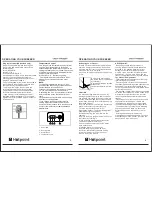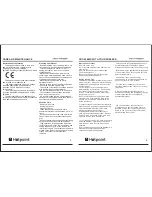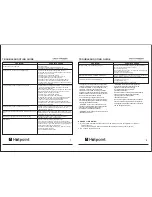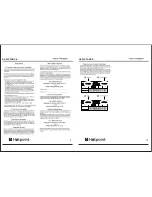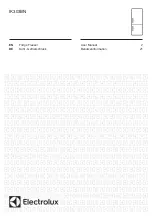
This
appliance
is
not intended for use by persons
(
including children
)
with
reduced
physical
,
sensory
or mental
capabilities, or lack of
experience and
knowledge
,
unless
they have been
given
supervision
or instruction concerning use
of
the
appliance by a
person
responsible
for
their safety.
Children should
be
supervised to ensure
that they
do not
play with the
appliance
. (
A2
:
06
)
Do not store explosive substances
such as
aerosol
cans
with
a flammable propellant in this
appliance
.
Appliances
which use
flammable insulation blowing
gases
,
instructions
shall include information
regarding disposal of
the appliance
(
IEC 60335
-
2
-
24
:
2010
)
-
WARNING Do not use electrical appliances
inside the food storage compartments
of
the
appliance
,
unless
they are of
the type
recommended by the manufacturer
(
IEC 60335
-
2
-
24
:
2010
)
-
WARNING Do not damage the refrigerant circuit
(
IEC 60335
-
2
-
24
:
2010
)
-
WARNING Do not use mechanical devices or
other means to accelerate the defrosting process,
other than those recommended by the
manufacturer
(
IEC 60335
-
2
-
24
:
2010
)
For compression
-
type appliances
which use
flammable refrigerants
,
instructions
shall
include
information pertaining
to the installation
,
handling
,
servicing
(
IEC 60335
-
2
-
24
:
2010
)
7
8
TROUBLESHOOTING GUIDE
TROUBLESHOOTING GUIDE
PROBLEM
POSSIBLE CAUSE
Not plugged in.
The circuit breaker tripped or a blown fuse.
The freezer temperature control is set at "0/OFF”
The room temperature is hotter than normal.
A large amount of food has been added to the freezer.
The door is open too often.
The door is not closed completely.
The temperature control is not set correctly.
The door gasket does not seal properly.
The freezer does not have the correct clearances.
The freezer has recently been disconnected for a
period of time. Four hours are required for the freezer
to cool down completely
Temperature control is set too warm. Turn the control
to a cooler setting and allow several hours for the
temperature to stabilize.
Door is kept open too long or is opened too frequently.
Warm air enters the freezer every time the door is
opened. Open the door less often.
The door is not closed completely.
The door gasket does not seal properly.
A large amount of warm or hot food might have been
stored recently. Wait until the freezer has had a
chance to reach its selected temperature.
The freezer has recently been disconnected for a
period of time. Four hours are required for the freezer
to cool down completely.
Temperature control is set too cold. Turn the control to
a warmer setting and allow several hours for the
temperature to stabilize
Freezer does not operate
Compressor turns on and off frequently
Temperature inside the freezer is too warm
Temperature inside the freezer is too cold
PROBLEM
POSSIBLE CAUSE
Metal parts undergo expansion and contraction, as in
hot water pipes. This is normal. Sound will level off or
disappear as freezer continues to run
Refrigerant (used to cool freezer) is circulating
throughout the system. This is normal
Check to assure that the freezer is level.
Floor is uneven or weak. Freezer rocks on the floor
when it is moved slightly. Be sure floor can adequately
support freezer. Level the freezer by putting wood or
metal shims under part of the freezer.
The freezer is touching the wall. Re-level the freezer
and move it from the wall.
See “Installation Instructions”
The freezer is not level.
The gasket is dirty.
The storage basket is out of position
Popping or cracking sound when compressor comes
on
Bubbling or gurgling sound, like water boiling
Vibrations
The door will not close properly
Weather is hot and humid, which increases internal
rate of frost build-up. This is normal.
Door is slightly open.
Door is kept open too long, or is opened too frequently.
Open the door less often.
The door is not sealed properly
Moisture forms on inside freezer walls
Door is slightly open, causing cold air from inside the
freezer to meet warm moist air from outside
Moisture forms on outside of freezer
DANGER or WARNING:
1. Risk of child entrapment. Before you throw away your old refrigerator or freezer:
-
Take off doors.
-
Leave the shelves in place so that children may not easily climb inside.”
2. Do not use extension cords.
This appliance is intended to be used in household
and similar applications
(
list
)


